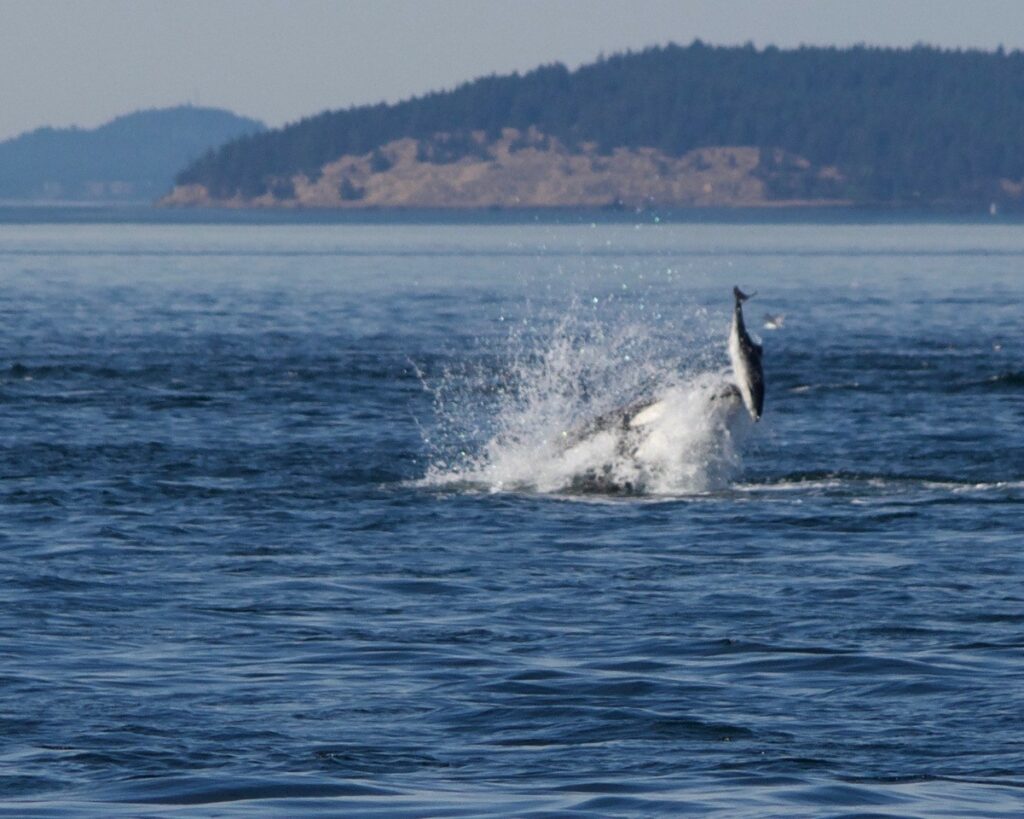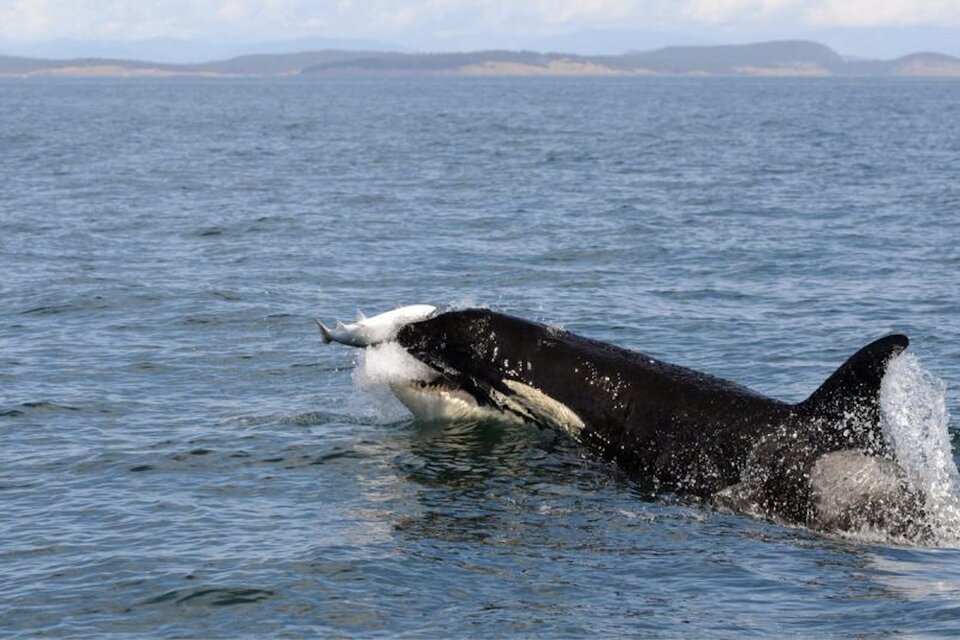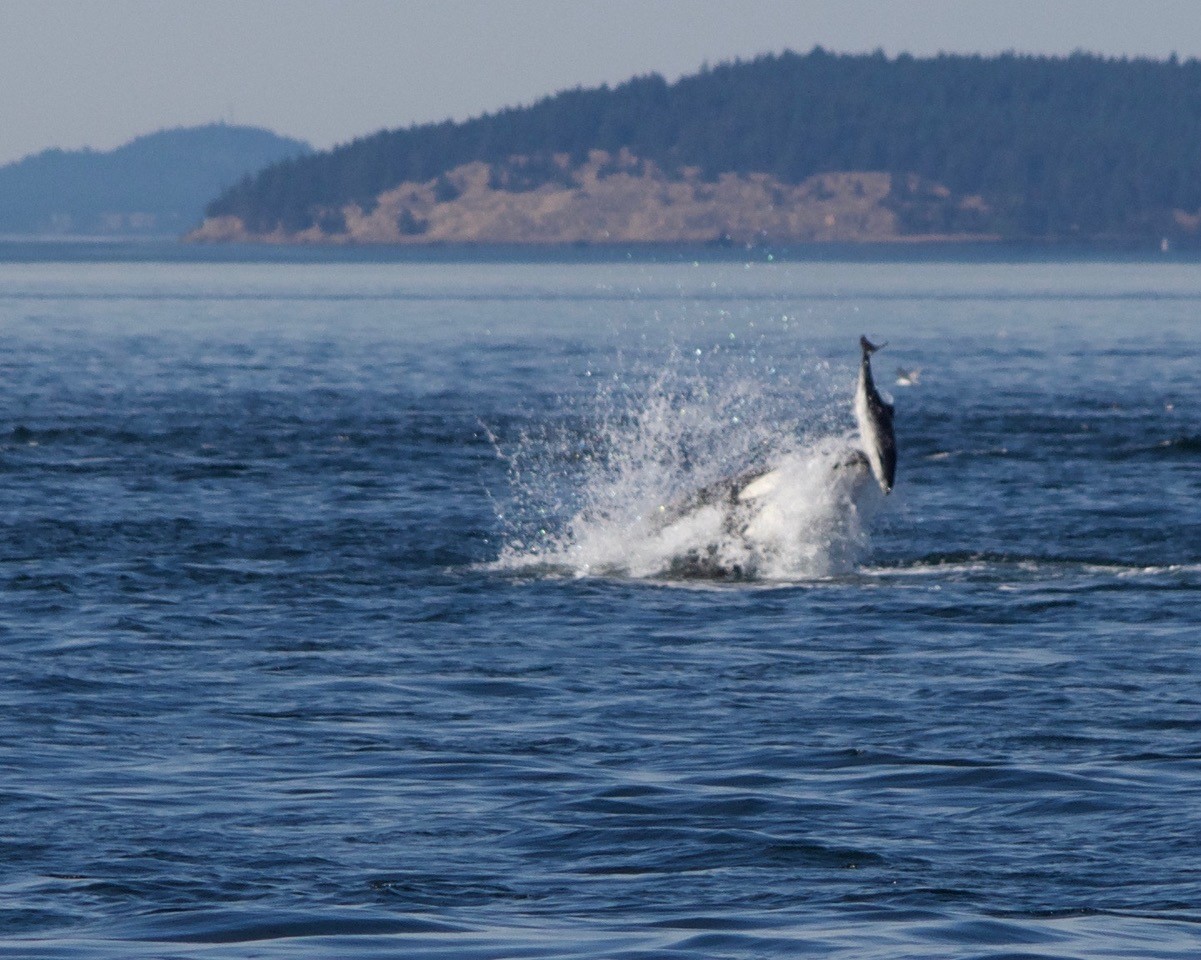Southern Resident Killer Whales are listed as endangered under both the U.S. Endangered Species Act (ESA) and Canada’s Species at Risk Act (SARA). Despite 4 new calves having been born in the past 6 months, the future of these beautiful whales remains uncertain. The facts of the matter are, this baby boom followed more than two years without the successful birth of a calf. Additionally, newborn Orcas face a 50 percent mortality rate. Between 1996 and 2001, the Resident population has declined by almost 20 percent and continues to fluctuate.
However, the news isn’t all bad… there is substantial recovery plan in place to address the issues currently affecting the Southern Resident Killer Whale population. In this blog we will take a closer look at the number one threat to the survival of the species, a decrease in the quantity and quality of their prey, specifically Chinook salmon. We will explore the relationship between salmon stocks and our local whales, and why saving our salmon is the key to the survival of these truly amazing animals.

Salmon account for 97 percent of the Resident Killer Whale diet, with Chinook salmon accounting for 78 percent of their total diet throughout the summer months. In the Pacific Northwest, 19 populations of wild and steelhead salmon are listed as threatened under the Endangered Species Act, with Chinook salmon being one of them. Resident Killer Whales specifically target Chinook salmon over other more abundant species of salmon, such as Pink and Sockeye, because they bigger and fattier. Unfortunately, this has created a situation where one threatened species is dependent on another threatened species.

Photo Credits: https://www.timescolonist.com/local-news/to-feed-endangered-whales-alaska-ordered-to-stop-intercepting-bc-bound-salmon-6962176
So what does this all mean? Essentially, this means that our local whales are continually struggling to find enough food to sustain themselves and their calves. Southern Resident Killer Whales must consume between 250-300lbs of salmon a day to stay healthy, many of them originating from the Fraser River population. Unfortunately, their need for such high quantities of salmon means that these whales consume between one-eighth to one-quarter of all returning Fraser River Chinook. In other words, the whales are taking a huge bite out of the Fraser River Chinook run, before they have a chance to spawn. And, as the whale population grows, more and more salmon will be needed to sustain them.
Chinook salmon runs originating in the Columbia/Snake River are also an important food source for the Resident Killer Whales’ survival. This particular population of Chinook is threated by a set of major dams in the Snake River. These dams kill many millions of Chinook salmon juveniles as they attempt to navigate the dams and migrate down river and out to the ocean. However, while these Dams are causing havoc for the salmon population, they are the largest source of electricity in the Pacific Northwest and the largest source of renewable electricity in the nation. Ultimately, as we have seen in environmental matters all over the world, the dams are a classic case of ‘Robbing Peter to pay Paul’.
Water toxins and vessel noise have also been identified as potential factors affecting the health of Southern Resident Killer Whales. Put simply, when the whales don’t have enough to eat, they metabolize their pollutant-filled fat stores. This in turn, compromises their immune system and reproductive capacity. When salmon stocks are low, noise from nearby vessels may make it more difficult for the whales to find and catch the few fish that are available. Therefore, efforts made to increase the number of salmon available to the whales, will in turn decrease the possible negative effects of both water toxins and vessel noise.
Population recovery for the Southern Resident population is a complicated problem to tackle, but it is clear that generating more Chinook salmon is one of the key ways that we can increase their chances of survival.
Fortunately, whale watchers, government agencies across the U.S. and Canada, and dedicated NGO’s like the Pacific Salmon Foundation are working hard to generate community awareness and assist with the recovery of salmon stocks.
Many wild salmon runs are now supplemented by significant numbers of hatchery-reared salmon. In Washington, hatchery fish now account for about three quarters of all Chinook and Coho salmon, and nearly 90 percent of all Steelhead harvested. Although the abundance of wild Chinook salmon continues to show a predominantly downward trend, the total number of salmon (incl. Pink, Spring, and Sockeye species) in Puget Sound, the eastern Strait of Juan de Fuca, and the lower Columbia River basin, has risen in recent decades due to production from hatcheries.
While hatcheries play an extremely important role in the recovery of salmon stocks in the Pacific Northwest, there are many other critical factors that need to be addressed and managed. These factors include:
- Targeted programs that prevent critical habits loss and protect salmon spawning grounds;
- Partnerships with commercial and recreational fishers, to reduce the mortality of non-targeted species, and to ensure current regulations and best-practice standards are followed;
- Continued research guide increase our understanding of the threats to salmon stocks, the most effective ways to support reproduction, and to guide fisheries management policy.
SpringTide is pleased to support the Pacific Salmon Foundation, an organization with a mission to provide thoughtful leadership in the conservation, restoration, and enhancement of Pacific salmon and their ecosystems. They play a crucial role in supporting the recovery of Pacific Salmon stocks and as result are also supporting the Southern Resident Killer Whale population.
With this in mind and in celebration of World Ocean’s Day on June 8, we are pleased to be donating $1 from every seat sold on this important day to the Pacific Salmon Foundation. You can book your World Ocean’s Day Whale Watching tour online today.
With your help and the ongoing work of organizations like the Pacific Salmon Foundation, we can make a difference to the lives of our local whales (and salmon!). Please spread the word by sharing this blog post!

